Synergistic Effects of Heat-Moisture Treatment Regime and Grape Peels Addition on Wheat Dough and Pasta Features
Abstract
1. Introduction
2. Materials and Methods
2.1. Materials and Treatment Regime
2.2. Dough and Pasta Manufacturing
2.3. Synergistic Effects of HMT and GPF on Dough Properties
2.3.1. Dough Rheological Behavior
2.3.2. Dough Texture
2.4. Synergistic Effects of HMT and GPF on Dry Pasta Properties
2.4.1. Dry Pasta Color
2.4.2. Total Polyphenolics Content (TPC)
2.4.3. Dietary Fiber Content (DF)
2.5. Synergistic Effects of HMT and GPF on Cooked Pasta Properties
2.5.1. Cooked Pasta Texture
2.5.2. Resistant Starch (RS) Determination
2.6. Optimization of HMT Regime and GPF Addition
3. Results
3.1. Pasta Dough Properties
3.2. Dry Pasta Properties
3.3. Cooked Pasta Properties
3.4. Optimization
3.5. Correlations between Dough and Pasta Properties
4. Discussion
5. Conclusions
Author Contributions
Funding
Institutional Review Board Statement
Informed Consent Statement
Data Availability Statement
Conflicts of Interest
References
- Borcean, I. Durum Wheat: Domestic Production, not Import. Available online: https://www.revista-ferma.ro/articole/agronomie/graul-durum-productie-autohtona-nu-import (accessed on 23 February 2021).
- Collar, C.; Armero, E. Functional and Thermal Behaviours of Heat-Moisture-Treated Starch-Rich Wheat-Based Blended Matrices: Impact of Treatment of Non-wheat Flours. Food Bioprocess Technol. 2019, 12, 599–612. [Google Scholar] [CrossRef]
- Iuga, M.; Mironeasa, S. A review of the hydrothermal treatments impact on starch based systems properties. Crit. Rev. Food Sci. Nutr. 2020, 60, 3890–3915. [Google Scholar] [CrossRef] [PubMed]
- Chen, X.; He, X.; Fu, X.; Huang, Q. In vitro digestion and physicochemical properties of wheat starch/flour modified by heat-moisture treatment. J. Cereal Sci. 2015, 63, 109–115. [Google Scholar] [CrossRef]
- Wang, H.; Zhang, B.; Chen, L.; Li, X. Understanding the structure and digestibility of heat-moisture treated starch. Int. J. Biol. Macromol. 2016, 88, 1–8. [Google Scholar] [CrossRef] [PubMed]
- Zavareze, E.D.R.; Dias, A.R.G. Impact of heat-moisture treatment and annealing in starches: A review. Carbohydr. Polym. 2011, 83, 317–328. [Google Scholar] [CrossRef]
- Liao, L.; Liu, H.; Gan, Z.; Wu, W. Structural properties of sweet potato starch and its vermicelli quality as affected by heat-moisture treatment. Int. J. Food Prop. 2019, 22, 1122–1133. [Google Scholar] [CrossRef]
- Iuga, M.; Mironeasa, C.; Mironeasa, S. Oscillatory Rheology and Creep-Recovery Behaviour of Grape Seed-Wheat Flour Dough: Effect of Grape Seed Particle Size, Variety and Addition Level. Bull. Univ. Agric. Sci. Veter. Med. Cluj Napoca. Food Sci. Technol. 2019, 76, 40–51. [Google Scholar] [CrossRef]
- Yu, J.; Ahmedna, M. Functional components of grape pomace: Their composition, biological properties and potential applications. Int. J. Food Sci. Technol. 2013, 48, 221–237. [Google Scholar] [CrossRef]
- Deng, Q.; Penner, M.H.; Zhao, Y. Chemical composition of dietary fiber and polyphenols of five different varieties of wine grape pomace skins. Food Res. Int. 2011, 44, 2712–2720. [Google Scholar] [CrossRef]
- Iuga, M.; Ropciuc, S.; Mironeasa, S. Antioxidant Activity and Total Phenolic Content of Grape Seeds and Peels from Romanian Varieties. Food Environ. Saf. J. 2017, 16, 276–282. [Google Scholar]
- Gaita, C.; Alexa, E.; Moigradean, D.; Filomena, C.; Poiana, M.-A. Designing of high value-added pasta formulas by incorporation of grape pomace skins. Rom. Biotechnol. Lett. 2020, 25, 1607–1614. [Google Scholar] [CrossRef]
- Savla, H.; Yardi, V. Development of Gluten-Free Pasta (Sevaiya) Using Grape Pomace and Assessing its Quality And Acceptability. Int. Proc. Chem. Biol. Environ. Eng. 2016, 95, 44–49. [Google Scholar] [CrossRef]
- Tolve, R.; Pasini, G.; Vignale, F.; Favati, F.; Simonato, B. Effect of Grape Pomace Addition on the Technological, Sensory, and Nutritional Properties of Durum Wheat Pasta. Foods 2020, 9, 354. [Google Scholar] [CrossRef] [PubMed]
- Gaceu, L.; Gruia, R.; Oprea, O.B. Researches Regarding the Superior Valorisation of By-Products From The Winery Industry, and the Obtaining of Bakery Products. Ann. Acad. Rom. Sci. Ser. Agric. Silvic. Vet. Med. Sci. 2020, 9, 25–36. [Google Scholar]
- Sant’Anna, V.; Christiano, F.D.P.; Marczak, L.D.F.; Tessaro, I.C.; Thys, R.C.S. The effect of the incorporation of grape marc powder in fettuccini pasta properties. LWT Food Sci. Technol. 2014, 58, 497–501. [Google Scholar] [CrossRef]
- Mironeasa, S.; Iuga, M.; Zaharia, D.; Mironeasa, C. Rheological Analysis of Wheat Flour Dough as Influenced by Grape Peels of Different Particle Sizes and Addition Levels. Food Bioprocess Technol. 2019, 12, 228–245. [Google Scholar] [CrossRef]
- Fanari, F.; Desogus, F.; Scano, E.A.; Carboni, G.; Grosso, M. The effect of the relative amount of ingredients on the rheological properties of semolina doughs. Sustainability 2020, 12, 2705. [Google Scholar] [CrossRef]
- Mironeasa, S.; Iuga, M.; Zaharia, D.; Mironeasa, C. Optimization of grape peels particle size and flour substitution in white wheat flour dough. Sci. Study Res. Chem. Chem. Eng. Biotechnol. Food Ind. 2019, 20, 29–42. [Google Scholar]
- Aghamirzaei, M.; Peighambardoust, S.H.; Azadmard-Damirchi, S.; Majzoobi, M. Effects of grape seed powder as a functional ingredient on flour physicochemical characteristics and dough rheological properties. J. Agric. Sci. Technol. 2015, 17, 365–373. [Google Scholar]
- Serna-Saldívar, S.O. Cereal Grains Laboratory Reference and Procedures Manual; CRC Press: Boca Raton, FL, USA, 2012; ISBN 9781466555631. [Google Scholar]
- Sicignano, A.; Di Monaco, R.; Masi, P.; Cavella, S. From raw material to dish: Pasta quality step by step. J. Sci. Food Agric. 2015, 95, 2579–2587. [Google Scholar] [CrossRef]
- Ciccoritti, R.; Scalfati, G.; Cammerata, A.; Sgrulletta, D. Variations in content and extractability of durum wheat (Triticum turgidum L. var durum) arabinoxylans associated with genetic and environmental factors. Int. J. Mol. Sci. 2011, 12, 4536–4549. [Google Scholar] [CrossRef] [PubMed]
- Hoover, R. The impact of heat-moisture treatment on molecular structures and properties of starches isolated from different botanical sources. Crit. Rev. Food Sci. Nutr. 2010, 50, 835–847. [Google Scholar] [CrossRef] [PubMed]
- Collar, C.; Armero, E. Value-added of heat moisture treated mixed flours in wheat-based matrices: A functional and nutritional approach. Food Bioprocess Technol. 2018, 11, 1536–1551. [Google Scholar] [CrossRef]
- Bergman, C.; Gualberto, D.; Weber, C. Development of a high-temperature-dried soft wheat pasta supplemented with cowpea (Vigna unguiculata (L) Walp)—Cooking quality, color, and sensory evaluation. Cereal Chem. 1994, 71, 523–527. [Google Scholar]
- Marchetti, L.; Cardós, M.; Campaña, L.; Ferrero, C. Effect of glutens of different quality on dough characteristics and breadmaking performance. LWT Food Sci. Technol. 2012, 46, 224–231. [Google Scholar] [CrossRef]
- Ungureanu-Iuga, M.; Dimian, M.; Mironeasa, S. Development and quality evaluation of gluten-free pasta with grape peels and whey powders. LWT Food Sci. Technol. 2020, 130, 1–9. [Google Scholar] [CrossRef]
- Troccoli, A.; Borrelli, G.M.; De Vita, P.; Fares, C.; Di Fonzo, N. Durum wheat quality: A multidisciplinary concept. J. Cereal Sci. 2000, 32, 99–113. [Google Scholar] [CrossRef]
- Melilli, M.G.; Pagliaro, A.; Scandurra, S.; Gentile, C.; Di Stefano, V. Omega-3 rich foods: Durum wheat spaghetti fortified with Portulaca oleracea. Food Biosci. 2020, 37, 100730. [Google Scholar] [CrossRef]
- Banga, J.R.; Balsa-Canto, E.; Moles, C.G.; Alonso, A.A. Improving food processing using modern optimization methods. Trends Food Sci. Technol. 2003, 14, 131–144. [Google Scholar] [CrossRef]
- Fanari, F.; Desogus, F.; Scano, E.A.; Carboni, G.; Grosso, M. The rheological properties of semolina doughs: Influence of the relative amount of ingredients. Chem. Eng. Trans. 2019, 76, 703–708. [Google Scholar] [CrossRef]
- Mann, J.; Schiedt, B.; Baumann, A.; Conde-Petit, B.; Vilgis, T.A. Effect of heat treatment on wheat dough rheology and wheat protein solubility. Food Sci. Technol. Int. 2014, 20, 341–351. [Google Scholar] [CrossRef]
- Lazaridou, A.; Marinopoulou, A.; Biliaderis, C.G. Impact of flour particle size and hydrothermal treatment on dough rheology and quality of barley rusks. Food Hydrocoll. 2019, 87, 561–569. [Google Scholar] [CrossRef]
- Fanari, F.; Carboni, G.; Grosso, M.; Desogus, F. Thermal properties of semolina doughs with different relative amount of ingredients. Sustainability 2020, 12, 2235. [Google Scholar] [CrossRef]
- Lindahl, L.; Eliasson, A.C. A comparison of some rheological properties of durum and wheat flour doughs. Cereal Chem. 1992, 69, 30–34. [Google Scholar]
- Peressini, D.; Cavarape, A.; Brennan, M.A.; Gao, J.; Brennan, C.S. Viscoelastic properties of durum wheat doughs enriched with soluble dietary fibres in relation to pasta-making performance and glycaemic response of spaghetti. Food Hydrocoll. 2020, 102, 105613. [Google Scholar] [CrossRef]
- Chavez-Murillo, C.E.; Orona-Padilla, J.L.; de la Rosa Millan, J. Physicochemical, functional properties and ATR-FTIR digestion analysis of thermally treated starches isolated from black and bayo beans. Starch/Staerke 2019, 71, 1–25. [Google Scholar] [CrossRef]
- Aksoylu, Z.; Çağindi, Ö.; Köse, E. Effects of blueberry, grape seed powder and poppy seed incorporation on physicochemical and sensory properties of biscuit. J. Food Qual. 2015, 38, 164–174. [Google Scholar] [CrossRef]
- Zheng, B.; Zhong, S.; Tang, Y.; Chen, L. Understanding the nutritional functions of thermally-processed whole grain highland barley in vitro and in vivo. Food Chem. 2020, 310, 125979. [Google Scholar] [CrossRef] [PubMed]
- Wang, H.; Liu, Y.; Chen, L.; Li, X.; Wang, J.; Xie, F. Insights into the multi-scale structure and digestibility of heat-moisture treated rice starch. Food Chem. 2018, 242, 323–329. [Google Scholar] [CrossRef]
- Biniari, K.; Gerogiannis, O.; Daskalakis, I.; Bouza, D.; Stavrakaki, M. Study of some qualitative and quantitative characters of the grapes of indigenous Greek grapevine varieties (Vitis vinifera L.) using HPLC and spectrophotometric analyses. Not. Bot. Horti Agrobot. Cluj-Napoca 2018, 46, 97–106. [Google Scholar] [CrossRef]
- Iuga, M.; Mironeasa, S. Potential of grape byproducts as functional ingredients in baked goods and pasta. Compr. Rev. Food Sci. Food Saf. 2020, 19, 2473–2505. [Google Scholar] [CrossRef]
- Mironeasa, S. Valorisation of Secondary Products from Wine Making; Publishing House Performantica: Iasi, Romania, 2017; p. 56. [Google Scholar]
- Liu, Y.F.; Laohasongkram, K.; Chaiwanichsiri, S. Effects of Heat-Moisture Treatment on Molecular Interactions and Physicochemical Properties of Tapioca Starch. MOJ Food Process. Technol. 2016, 3, 304–311. [Google Scholar] [CrossRef]
- Galvez, F.C.F.; Resurreccion, A.V.A. Reliability of the Focus Group Technique in Determining the Quality Characteristics of Mungbean [Vigna Radiata (L.) Wilczec] Noodles. J. Sens. Stud. 1992, 7, 315–326. [Google Scholar] [CrossRef]
- Li, M.; Liu, C.; Zheng, X.; Li, L.; Bian, K. Physicochemical properties of wheat flour modified by heat-moisture treatment and their effects on noodles making quality. J. Food Process. Preserv. 2020, 44, 1–9. [Google Scholar] [CrossRef]
- Chandla, N.K.; Saxena, D.C.; Singh, S. Processing and evaluation of heat moisture treated (HMT) amaranth starch noodles; An inclusive comparison with corn starch noodles. J. Cereal Sci. 2017, 75, 306–313. [Google Scholar] [CrossRef]
- Chen, J.S.; Fei, M.J.; Shi, C.L.; Tian, J.C.; Sun, C.L.; Zhang, H.; Ma, Z.; Dong, H.X. Effect of particle size and addition level of wheat bran on quality of dry white Chinese noodles. J. Cereal Sci. 2011, 53, 217–224. [Google Scholar] [CrossRef]
- Barros, J.H.T.; Telis, V.R.N.; Taboga, S.; Franco, C.M.L. Resistant starch: Effect on rheology, quality, and staling rate of white wheat bread. J. Food Sci. Technol. 2018, 55, 4578–4588. [Google Scholar] [CrossRef] [PubMed]
- Rocchetti, G.; Giuberti, G.; Busconi, M.; Marocco, A.; Trevisan, M.; Lucini, L. Pigmented sorghum polyphenols as potential inhibitors of starch digestibility: An in vitro study combining starch digestion and untargeted metabolomics. Food Chem. 2020, 312, 126077. [Google Scholar] [CrossRef]
- McDougall, G.J.; Shpiro, F.; Dobson, P.; Smith, P.; Blake, A.; Stewart, D. Different Polyphenolic Components of Soft Fruits Inhibit α-Amylase and α-Glucosidase. J. Agric. Food Chem. 2005, 53, 2760–2766. [Google Scholar] [CrossRef]
- Nakov, G.; Brandolini, A.; Hidalgo, A.; Ivanova, N.; Stamatovska, V.; Dimov, I. Effect of grape pomace powder addition on chemical, nutritional and technological properties of cakes. LWT 2020, 134, 109950. [Google Scholar] [CrossRef]
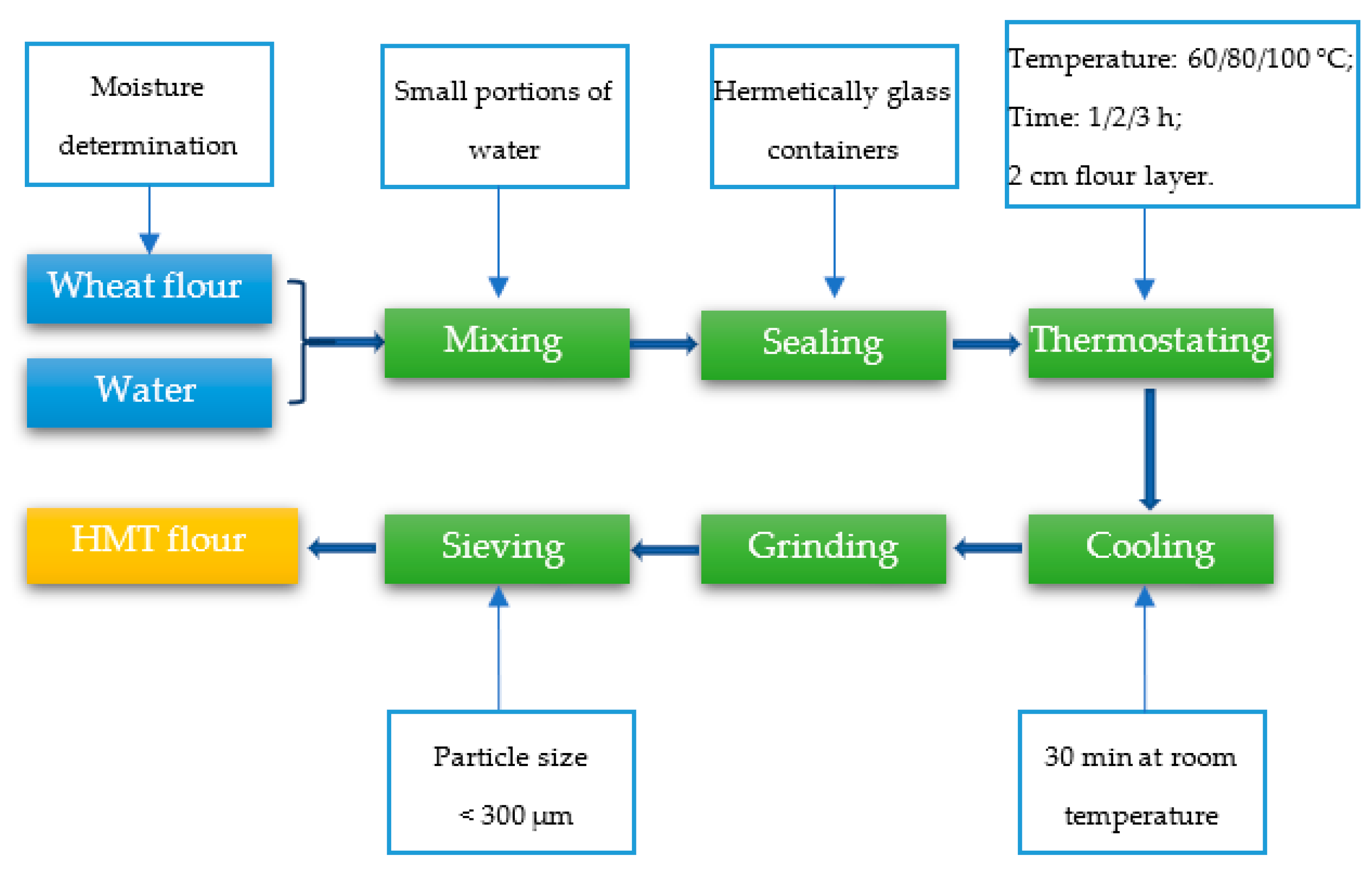
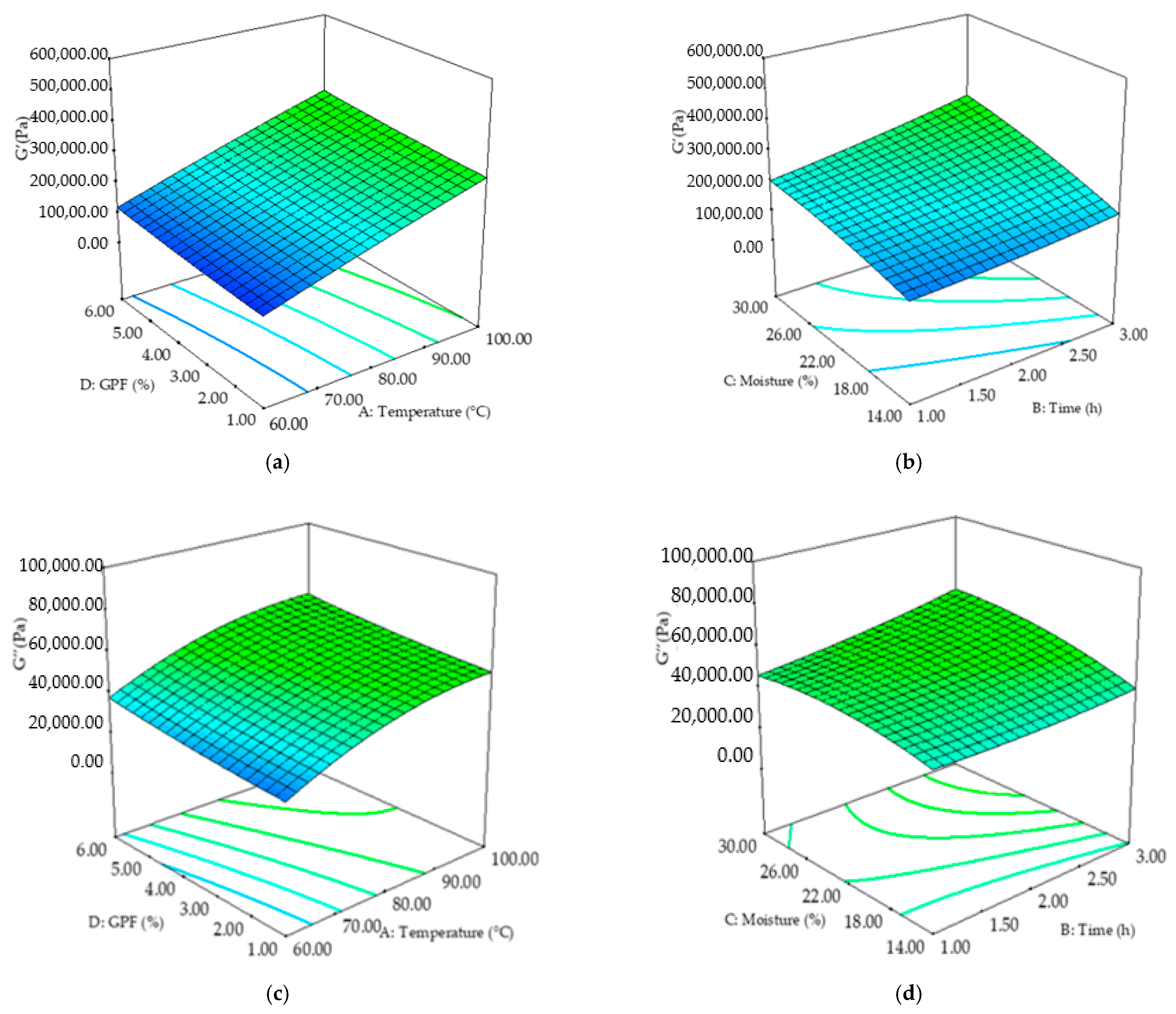


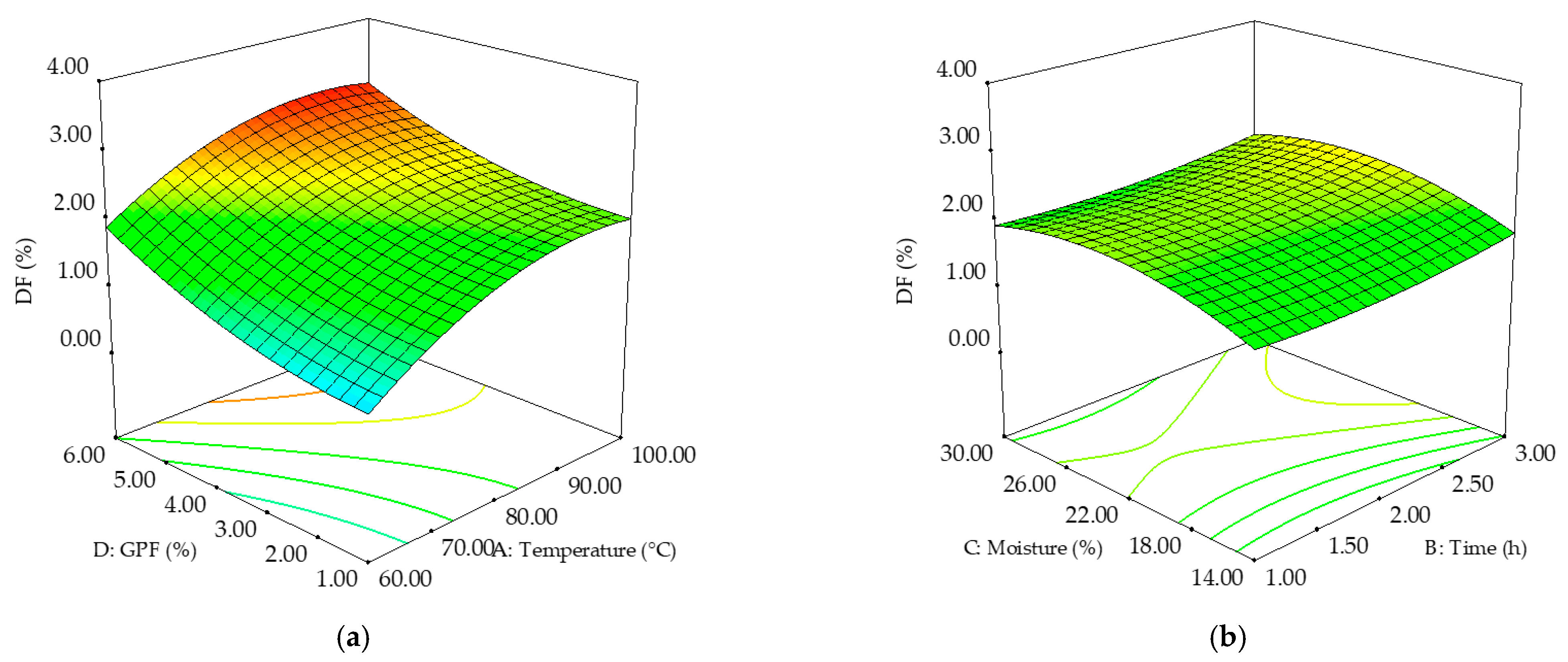


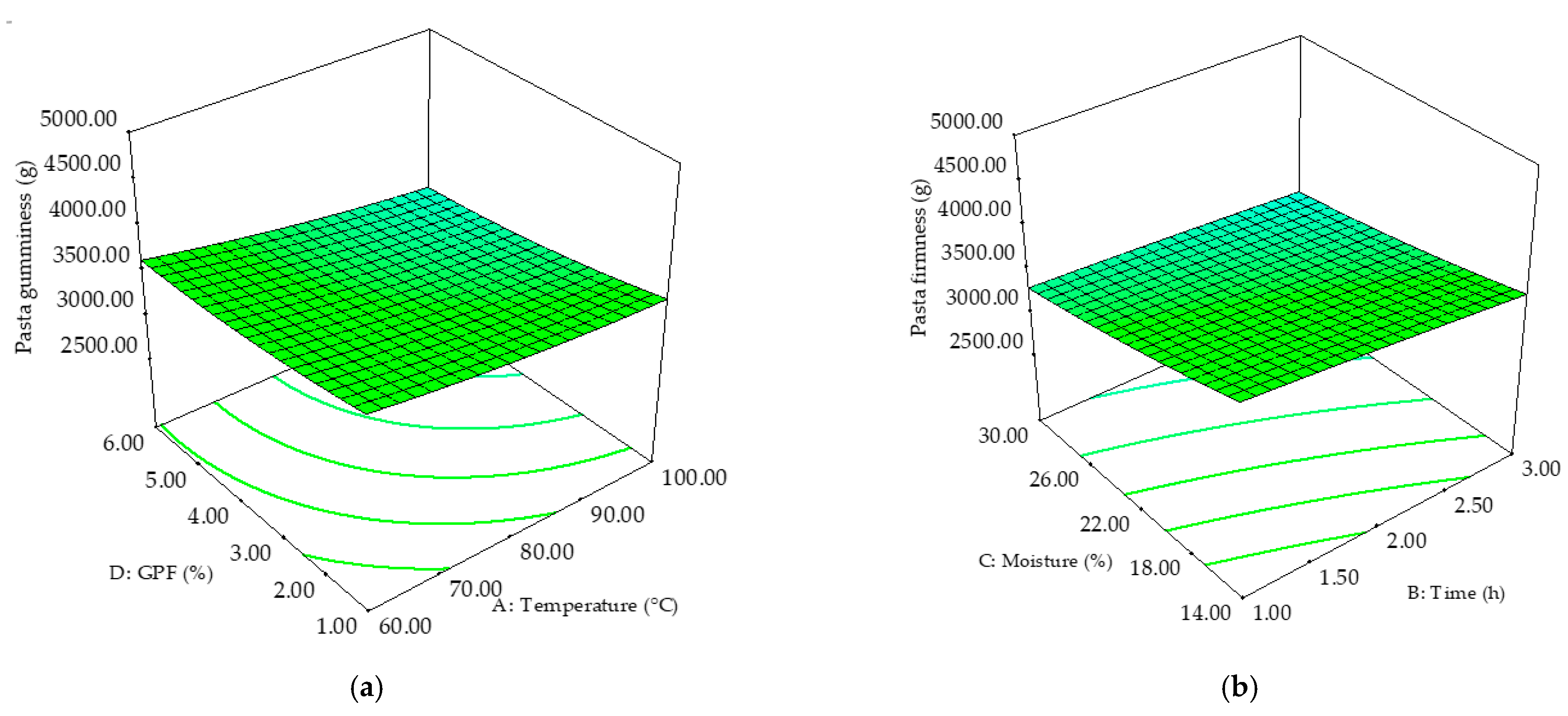
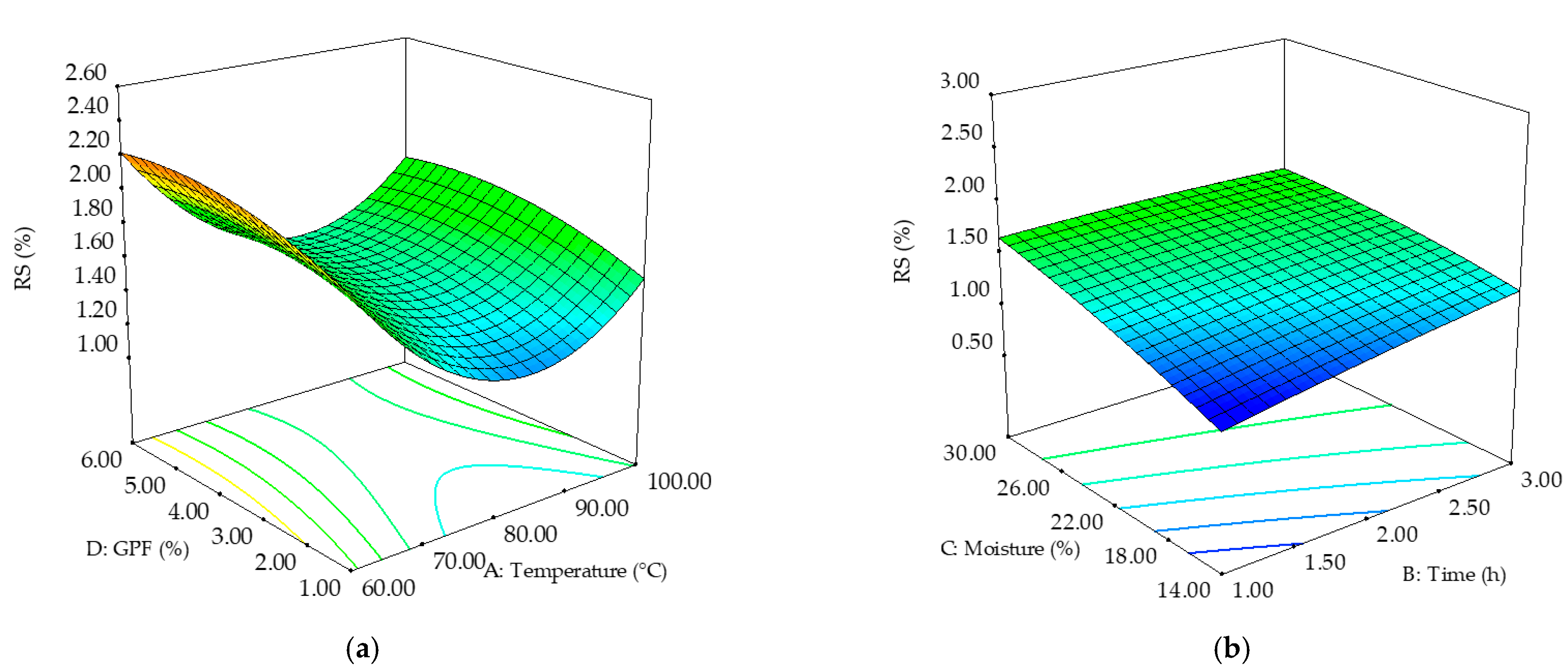
| Exp. No | Coded Values of Factors | Real Values of Factors | Values of the Responses | ||||||||||||||
|---|---|---|---|---|---|---|---|---|---|---|---|---|---|---|---|---|---|
| A | B | C | D | Temperature (°C) | Time (h) | Moisture (%) | GPF Level (%) | G’ (Pa) | G” (Pa) | Dough Firmness (g) | L* | RS (%) | TPC (mg GAE/ 100 g) | Pasta Firmness (g) | Pasta Gumminess (g) | DF (%) | |
| 1 | −1.00 | −1.00 | −1.00 | −1.00 | 60.00 | 1.00 | 14.00 | 1.00 | 65,243.33 ± 4125.49 | 21,620.00 ± 1230.49 | 2394.67 ± 80.64 | 72.50 ± 0.20 | 1.35 ± 0.03 | 10.40 ± 0.14 | 5582.33 ± 139.52 | 4582.05 ± 64,67 | 0.04 ± 0.02 |
| 2 | −1.00 | −1.00 | −1.00 | 1.00 | 60.00 | 1.00 | 14.00 | 6.00 | 115,366.67 ± 6107.65 | 36,690.00 ± 1839.59 | 2851.67 ± 98.29 | 65.25 ± 0.14 | 1.75 ± 0.02 | 12.85 ± 0.08 | 5077.00 ± 30.05 | 3979.43 ± 103.13 | 1.10 ± 0.00 |
| 3 | −1.00 | −1.00 | 1.00 | −1.00 | 60.00 | 1.00 | 30.00 | 1.00 | 92,510.00 ± 4133.63 | 28,150.00 ± 1192.64 | 2317.33 ± 39.80 | 73.37 ± 0.19 | 2.21 ± 0.03 | 10.42 ± 0.36 | 4769.00 ± 99.83 | 3702.50 ± 88.17 | 0.85 ± 0.05 |
| 4 | −1.00 | −1.00 | 1.00 | 1.00 | 60.00 | 1.00 | 30.00 | 6.00 | 96,053.33 ± 7110.29 | 29,543.33 ± 2363.90 | 2529.00 ± 87.54 | 65.09 ± 0.86 | 2.39 ± 0.04 | 14.38 ± 0.41 | 5532.67 ± 38.73 | 3475.66 ± 133.51 | 1.95 ± 0.05 |
| 5 | −1.00 | 0.00 | 0.00 | 0.00 | 60.00 | 2.00 | 22.00 | 3.50 | 96,845.00 ± 985.00 | 30,820.00 ± 750.00 | 2382.33 ± 85.65 | 68.44 ± 0.40 | 2.36 ± 0.06 | 11.70 ± 0.23 | 5646.67 ± 161.38 | 3571.40 ± 32.50 | 1.10 ± 0.00 |
| 6 | −1.00 | 1.00 | −1.00 | −1.00 | 60.00 | 3.00 | 14.00 | 1.00 | 62,435.00 ± 2745.00 | 20,715.00 ± 1025.00 | 2087.67 ± 43.82 | 71.44 ± 0.29 | 1.69 ± 0.02 | 8.85 ± 0.08 | 5257.67 ± 149.31 | 3917.56 ± 188.13 | 0.10 ± 0.00 |
| 7 | −1.00 | 1.00 | −1.00 | 1.00 | 60.00 | 3.00 | 14.00 | 6.00 | 110,300.00 ± 4500.00 | 36,245.00 ± 1305.00 | 2973.67 ± 179.62 | 63.42 ± 0.33 | 2.09 ± 0.03 | 14.09 ± 0.35 | 4749.00 ± 209.16 | 3640.87 ± 114.96 | 1.35 ± 0.05 |
| 8 | −1.00 | 1.00 | 1.00 | −1.00 | 60.00 | 3.00 | 30.00 | 1.00 | 111,300.00 ± 9139.47 | 31,683.33 ± 2632.38 | 2593.67 ± 81.86 | 74.33 ± 74.33 | 2.14 ± 0.03 | 10.22 ± 0.18 | 5171.19 ± 41.56 | 3319.90 ± 78.63 | 1.10 ± 0.00 |
| 9 | −1.00 | 1.00 | 1.00 | 1.00 | 60.00 | 3.00 | 30.00 | 6.00 | 123,733.33 ± 7958.85 | 36,056.67 ± 2643.56 | 2830.00 ± 28.35 | 68.60 ± 0.13 | 2.32 ± 0.02 | 14.20 ± 0.24 | 5509.38 ± 256.63 | 3703.64 ± 230.56 | 2.20 ± 0.10 |
| 10 | 0.00 | −1.00 | 0.00 | 0.00 | 80.00 | 1.00 | 22.00 | 3.50 | 179,900.00 ± 12,019.98 | 48,253.33 ± 2805.54 | 2607.00 ± 181.35 | 72.51 ± 0.07 | 1.41 ± 0.04 | 11.83 ± 0.33 | 4690.00 ± 115.57 | 3439.52 ± 45.24 | 2.10 ± 0.00 |
| 11 | 0.00 | 0.00 | −1.00 | 0.00 | 80.00 | 2.00 | 14.00 | 3.50 | 90,680.00 ± 6131.86 | 29,120.00 ± 1993.66 | 2592.33 ± 125.01 | 69.31 ± 0.21 | 1.30 ± 0.01 | 12.21 ± 0.08 | 4569.00 ± 51.51 | 3826.95 ± 117.56 | 1.30 ± 0.10 |
| 12 | 0.00 | 0.00 | 0.00 | −1.00 | 80.00 | 2.00 | 22.00 | 1.00 | 192,200.00 ± 6773.48 | 46,030.00 ± 1203.37 | 2623.67 ± 70.74 | 77.52 ± 0.15 | 1.35 ± 0.03 | 9.64 ± 0.05 | 4782.67 ± 192.73 | 3758.35 ± 194.28 | 1.65 ± 0.05 |
| 13 | 0.00 | 0.00 | 0.00 | 0.00 | 80.00 | 2.00 | 22.00 | 3.50 | 171,123.33 ± 85,406.97 | 49,411.17 ± 4023.58 | 3036.04 ± 148.87 | 69.57 ± 1.58 | 1.40 ± 0.02 | 12.60 ± 0.26 | 4471.00 ± 160.08 | 3478.30 ± 78.55 | 2.25 ± 0.04 |
| 14 | 0.00 | 0.00 | 0.00 | 1.00 | 80.00 | 2.00 | 22.00 | 6.00 | 243,933.33 ± 7211.33 | 59,853.33 ± 2311.54 | 3365.33 ± 116.98 | 66.32 ± 0.04 | 1.46 ± 0.01 | 12.70 ± 0.70 | 4676.67 ± 188.60 | 3260.48 ± 14.93 | 2.95 ± 0.15 |
| 15 | 0.00 | 0.00 | 1.00 | 0.00 | 80.00 | 2.00 | 30.00 | 3.50 | 311,533.33 ± 18,779.33 | 65,976.67 ± 4810.64 | 4694.33 ± 444.08 | 73.20 ± 0.65 | 1.62 ± 0.05 | 11.06 ± 0.22 | 4589.67 ± 257.41 | 3151.64 ± 173.89 | 2.15 ± 0.05 |
| 16 | 0.00 | 1.00 | 0.00 | 0.00 | 80.00 | 3.00 | 22.00 | 3.50 | 259,600.00 ± 15,661.42 | 58,203.33 ± 4250.84 | 3443.67 ± 110.21 | 72.36 ± 0.51 | 1.58 ± 0.01 | 11.00 ± 0.22 | 5504.00 ± 184.46 | 3438.89 ± 94.96 | 2.25 ± 0.05 |
| 17 | 1.00 | −1.00 | −1.00 | −1.00 | 100.00 | 1.00 | 14.00 | 1.00 | 146,400.00 ± 13,596.69 | 38,243.33 ± 3639.13 | 3697.67 ± 53.61 | 77.52 ± 0.06 | 1.01 ± 0.00 | 9.73 ± 0.19 | 3750.33 ± 168.00 | 3913.92 ± 149.77 | 1.70 ± 0.00 |
| 18 | 1.00 | −1.00 | −1.00 | 1.00 | 100.00 | 1.00 | 14.00 | 6.00 | 194,733.33 ± 6165.50 | 50,006.67 ± 1664.52 | 3856.00 ± 131.64 | 63.91 ± 0.37 | 1.30 ± 0.02 | 13.67 ± 0.22 | 4415.67 ± 214.31 | 3599.77 ± 71.85 | 2.90 ± 0.10 |
| 19 | 1.00 | −1.00 | 1.00 | −1.00 | 100.00 | 1.00 | 30.00 | 1.00 | 244,766.67 ± 5784.75 | 41,600.00 ± 1398.71 | 6012.67 ± 374.68 | 77.72 ± 0.18 | 1.84 ± 0.03 | 8.46 ± 0.38 | 4232.00 ± 118.44 | 3328.82 ± 152.72 | 1.80 ± 0.00 |
| 20 | 1.00 | −1.00 | 1.00 | 1.00 | 100.00 | 1.00 | 30.00 | 6.00 | 345,150.00 ± 750.00 | 57,360.00 ± 1120.00 | 6505.33 ± 104.58 | 71.21 ± 0.15 | 1.87 ± 0.02 | 12.24 ± 0.08 | 4699.33 ± 95.35 | 3229.02 ± 24.20 | 2.20 ± 0.10 |
| 21 | 1.00 | 0.00 | 0.00 | 0.00 | 100.00 | 2.00 | 22.00 | 3.5 | 321,033.33 ± 11,834.84 | 59,920.00 ± 2044.70 | 5869.00 ± 156.60 | 73.53 ± 0.37 | 1.72 ± 0.02 | 7.72 ± 0.25 | 4225.00 ± 189.81 | 3413.43 ± 63.80 | 2.15 ± 0.25 |
| 22 | 1.00 | 1.00 | −1.00 | −1.00 | 100.00 | 3.00 | 14.00 | 1.00 | 195,550.00 ± 8150.00 | 38,915.00 ± 1865.00 | 5956.33 ± 50.82 | 77.34 ± 0.13 | 1.39 ± 0.03 | 6.94 ± 0.03 | 4445.67 ± 105.70 | 3718.83 ± 166.23 | 2.20 ± 0.10 |
| 23 | 1.00 | 1.00 | −1.00 | 1.00 | 100.00 | 3.00 | 14.00 | 6.00 | 343,300.00 ± 11,200.00 | 63,195.00 ± 525.00 | 6502.67 ± 70.01 | 71.28 ± 0.15 | 1.88 ± 0.04 | 9.99 ± 0.03 | 3405.33 ± 335.50 | 3451.07 ± 151.60 | 3.00 ± 0.10 |
| 24 | 1.00 | 1.00 | 1.00 | −1.00 | 100.00 | 3.00 | 30.00 | 1.00 | 566,866.67 ± 23,071.70 | 85,683.33 ± 3634.37 | 3522.33 ± 264.08 | 74.43 ± 0.20 | 1.81 ± 0.01 | 7.04 ± 0.03 | 3598.33 ± 56.70 | 3365.23 ± 47.14 | 1.60 ± 0.10 |
| 25 | 1.00 | 1.00 | 1.00 | 1.00 | 100.00 | 3.00 | 30.00 | 6.00 | 441,700.00 ± 42,785.63 | 67,473.33 ± 6410.43 | 3423.33 ± 58.71 | 71.53 ± 0.34 | 2.10 ± 0.02 | 10.13 ± 0.20 | 3500.67 ± 47.17 | 2645.07 ± 67.37 | 2.90 ± 0.00 |
| Factor | G’ (Pa) | G” (Pa) | Dough Firmness (g) |
|---|---|---|---|
| Constant | 211,420.21 | 51,275.41 | 3248.00 |
| A | 106,984.07 ** | 12,826.30 ** | 1243.63 ** |
| B | 40,814.54 ** | 4816.85 ** | 31.22 |
| C | 56,089.17 ** | 6043.15 ** | 84.19 |
| D | 18,722.13 ** | 4654.63 ** | 201.72 * |
| A × B | 36,110.73 ** | 3710.00 ** | −66.21 |
| A × C | 40,515.52 ** | 3224.58 ** | −31.96 |
| A × D | 3583.44 | −173.33 | −43.29 |
| B × C | 17,204.90 * | 3233.33 ** | −607.21 ** |
| B × D | −7468.85 | −1125.83 | 15.63 |
| C × D | −18,929.90 ** | −3957.92 ** | −75.37 |
| A2 | −4938.95 | −6526.83 ** | 807.01 ** |
| B2 | 5871.89 | 1331.50 | −293.32 |
| C2 | −12,771.45 | −4348.50 | 324.68 |
| D2 | 4188.55 | 1044.84 | −324.16 |
| Model diagnostic | |||
| p-value | <0.01 | <0.01 | <0.01 |
| R2 | 0.93 | 0.86 | 0.76 |
| Adj.-R2 | 0.91 | 0.83 | 0.71 |
| Factor | L* | DF (%) | TPC (mg GAE/100 g) |
|---|---|---|---|
| Constant | 71.10 | 2.11 | 11.52 |
| A | 2.00 ** | 0.59 ** | −1.18 ** |
| B | 0.31 | 0.11 ** | −0.64 ** |
| C | 0.97 ** | 0.17 ** | −0.03 |
| D | −3.86 ** | 0.53 ** | 1.81 ** |
| A × B | 0.16 | 0.02 | −0.58 ** |
| A × C | −0.25 | −0.30 ** | −0.34 ** |
| A × D | 0.01 | −0.05 * | −0.11 |
| B × C | −0.17 | 0.01 | 0.18 |
| B × D | 0.81 ** | 0.04 | 0.08 |
| C × D | 0.72 ** | −0.03 | 0.01 |
| A2 | −0.62 | −0.44 ** | −1.45 ** |
| B2 | 0.82 | 0.11 | 0.25 |
| C2 | −0.36 | −0.34 ** | 0.47 * |
| D2 | 0.30 | 0.24 ** | 0.01 |
| Model diagnostic | |||
| p-value | <0.01 | <0.01 | <0.01 |
| R2 | 0.87 | 0.97 | 0.92 |
| Adj.-R2 | 0.84 | 0.96 | 0.90 |
| Factor | Pasta Firmness (g) | Pasta Gumminess (g) | RS (%) |
|---|---|---|---|
| Constant | 4773.37 | 3454.78 | 1.49 |
| A | −612.37 ** | −179.33 ** | −0.19 ** |
| B | −89.28 * | −113.87 ** | 0.10 ** |
| C | 19.46 | −261.61 ** | 0.25 ** |
| D | −1.30 | −145.68 ** | 0.13 ** |
| A × B | −117.10 * | 16.65 | 0.04 ** |
| A × C | −18.93 | −12.33 | −0.01 |
| A × D | −5.82 | −42.47 | −0.01 |
| B × C | −30.36 | 40.29 | −0.10 ** |
| B × D | −168.72 ** | 22.66 | 0.03 * |
| C × D | 178.78 ** | 49.88 | −0.06 ** |
| A2 | 61.68 | 45.48 | 0.52 ** |
| B2 | 222.84 | −7.73 | −0.02 |
| C2 | −294.82 * | 42.35 | −0.05 |
| D2 | −144.49 | 62.48 | −0.11 ** |
| Model diagnostic | |||
| p-value | <0.01 | <0.01 | <0.01 |
| R2 | 0.79 | 0.79 | 0.96 |
| Adj.-R2 | 0.75 | 0.74 | 0.95 |
| Variable | Min | Max | Optimal |
|---|---|---|---|
| A—Temperature (°C) | 60.00 | 100.00 | 87.56 |
| B—Time (h) | 1.00 | 3.00 | 3.00 |
| C—Moisture (%) | 14.00 | 30.00 | 26.01 |
| D—GPF level (%) | 1.00 | 6.00 | 4.81 |
| G’ (Pa) | 59,690.00 | 586,600.00 | 355,471.01 |
| G” (Pa) | 19,690.00 | 89,870.00 | 67,972.84 |
| Dough firmness (g) | 2058.00 | 6622.00 | 3355.70 |
| L* | 63.06 | 77.93 | 71.90 |
| RS (%) | 1.01 | 2.43 | 1.69 |
| TPC (mg GAE/100 g) | 6.90 | 14.85 | 11.36 |
| Pasta firmness (g) | 3028.00 | 5798.00 | 4473.80 |
| Pasta gumminess (g) | 2575.70 | 4649.91 | 3132.90 |
| DF (%) | 0.02 | 3.10 | 2.80 |
| Variables | L* | Dough Firmness (g) | Pasta Firmness (g) | Pasta Gumminess (g) | G’ (Pa) | G” (Pa) | TPC (mg GAE/100 g) | DF (%) | RS (%) |
|---|---|---|---|---|---|---|---|---|---|
| L* | 1.00 | 0.32 ** | −0.31 * | −0.02 | 0.26 * | 0.13 | −0.81 ** | −0.12 | −0.27 * |
| Dough firmness (g) | 1.00 | −0.51 ** | −0.33 ** | 0.54 ** | 0.48 ** | −0.39 ** | 0.51 ** | −0.09 | |
| Pasta firmness (g) | 1.00 | 0.43 ** | −0.68 ** | −0.63 ** | 0.42 ** | −0.49 ** | 0.27 * | ||
| Pasta Gumminess (g) | 1.00 | −0.64 ** | −0.64 ** | 0.03 | −0.65 ** | −0.31 * | |||
| G’ (Pa) | 1.00 | 0.95 ** | −0.41 ** | 0.57 ** | −0.01 | ||||
| G” (Pa) | 1.00 | −0.23 * | 0.68 ** | −0.11 | |||||
| TPC (mg GAE/100 g) | 1.00 | 0.17 | 0.19 | ||||||
| DF (%) | 1.00 | −0.10 | |||||||
| RS (%) | 1.00 |
Publisher’s Note: MDPI stays neutral with regard to jurisdictional claims in published maps and institutional affiliations. |
© 2021 by the authors. Licensee MDPI, Basel, Switzerland. This article is an open access article distributed under the terms and conditions of the Creative Commons Attribution (CC BY) license (https://creativecommons.org/licenses/by/4.0/).
Share and Cite
Iuga, M.; Batariuc, A.; Mironeasa, S. Synergistic Effects of Heat-Moisture Treatment Regime and Grape Peels Addition on Wheat Dough and Pasta Features. Appl. Sci. 2021, 11, 5403. https://doi.org/10.3390/app11125403
Iuga M, Batariuc A, Mironeasa S. Synergistic Effects of Heat-Moisture Treatment Regime and Grape Peels Addition on Wheat Dough and Pasta Features. Applied Sciences. 2021; 11(12):5403. https://doi.org/10.3390/app11125403
Chicago/Turabian StyleIuga, Mădălina, Ana Batariuc, and Silvia Mironeasa. 2021. "Synergistic Effects of Heat-Moisture Treatment Regime and Grape Peels Addition on Wheat Dough and Pasta Features" Applied Sciences 11, no. 12: 5403. https://doi.org/10.3390/app11125403
APA StyleIuga, M., Batariuc, A., & Mironeasa, S. (2021). Synergistic Effects of Heat-Moisture Treatment Regime and Grape Peels Addition on Wheat Dough and Pasta Features. Applied Sciences, 11(12), 5403. https://doi.org/10.3390/app11125403








